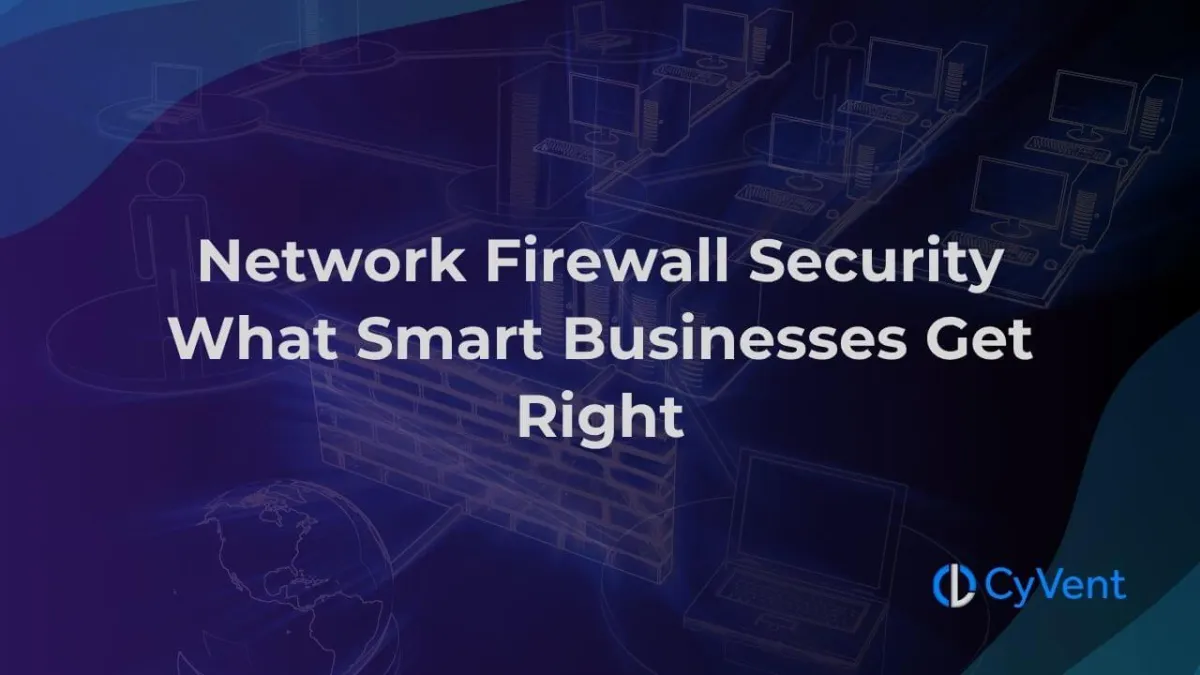
What Smart Businesses Get Right About Firewall Security
By CyVent Team
In a world obsessed with AI and cloud security, network firewall security often takes a back seat.
But here’s the truth: firewalls are still foundational. Their primary function is filtering network traffic to monitor and control data flow, protecting against unauthorized access, external threats, and malicious software. Done right, they improve network protection and reduce security breaches. But the way your organization configures, manages, and evolves its firewall policy can be the difference between early threat detection and a full-blown breach.
Here’s what smart businesses are doing differently.
Why Firewalls Still Matter in 2025

Traditional firewalls were built for simpler times. But today’s modern firewalls are smarter, faster, and integrated with AI and threat intelligence. They don’t just block bad IP addresses - they use deep packet inspection to analyze data packets, inspect encrypted traffic, and detect malicious software in real time.
In 2025, firewalls serve as strategic enforcement points in a world where:
Perimeters are blurry
Remote access and remote logins are the norm
Threats are faster and more evasive
Misconfigured firewall rules or outdated security settings can be an open invitation to attackers.
Types of Firewalls (and Why It Matters)

Not every firewall solution works the same. Choosing the right firewall device depends on your setup - cloud, hybrid, or on-prem - and how you analyze traffic and enforce security policies.
Packet-Filtering Firewalls
The most basic. These operate at the network layer and filter incoming and outgoing traffic based on source and destination IP addresses. Lightweight - but unable to inspect the contents of network packets.
Stateful Inspection Firewalls
These track sessions using stateful inspection to evaluate context. Smarter than stateless firewalls, which only review individual packets in isolation.
Proxy Firewalls
Proxy firewalls prevent direct connections between users and external resources. They isolate and inspect outgoing network traffic, improving data security.
Next Generation Firewalls (NGFWs)
NGFWs support intrusion prevention, application-layer filtering, and dynamic threat detection. They function as unified threat management systems for enterprise environments.
Cloud Native Firewalls / FWaaS
Cloud native firewalls offer centralized management and scalable protection for hybrid environments, including platforms like Oracle Cloud Infrastructure.
Firewalls Are the First Line of Defense - But Not the Only One

A network firewall is your first line of defense. But pairing it with intrusion detection and an intrusion prevention system creates depth. These systems monitor outgoing network traffic based on established rules and flag anomalies in real time.
Together, firewalls protect against known and unknown threats, especially when integrated with SIEM or XDR tools.
Where Most Businesses Go Wrong

Common mistakes include:
Treating firewalls as static tools
Failing to segment corporate networks
Creating overly permissive rules
Ignoring encrypted traffic
Letting outdated firewall configurations build up
Not reviewing firewall logs or monitoring logs
And worst of all: not inspecting encrypted traffic, which now accounts for over 90% of online activity.
Best Practices for Firewall Configuration & Management

If you want effective firewall security, follow these principles:
Segment Your Network
Separate zones by risk level and function. A trusted internal network helps limit lateral movement from unauthorized users.
Apply Least Privilege
Only allow what’s needed. Deny everything else. This reduces exposure and controls outgoing traffic.
Review Firewall Rules Regularly
Audit firewall rules to eliminate legacy permissions. Align changes with evolving security policies.
Monitor and Log Everything
Send firewall logs to your SIEM. Real-time alerting and log monitoring are critical for fast response.
Automate Intelligence
Leverage next-generation firewall tools that auto-update using threat intelligence feeds for rapid protection.
Integrating Firewalls with Other Security Tools

Integrate your network firewall with:
Intrusion detection and intrusion prevention systems
VPNs to secure access to private networks
SIEM platforms for centralized monitoring
This ensures filtering traffic is consistent across all locations and users.
Choosing the Right Firewall Solution

Ask yourself:
Is your infrastructure on-prem, hybrid, or cloud native?
Do you need hardware firewalls or cloud firewalls?
Who will manage firewall configurations?
What compliance standards apply (HIPAA, PCI-DSS, GDPR)?
Align your firewall solution to your network architecture and business needs.
Small Business Firewall Strategy

Use stateful inspection firewalls with clear security rules. Lean on managed services to protect devices and maintain compliance, without overcomplicating your environment.
Enterprise Firewall Strategy

Larger organizations benefit from:
Deep packet inspection
Scalable firewall policy control
Centralized visibility across locations and departments
This enables early detection of cyber attacks and better protection of sensitive data.
Firewalls Are Only as Good as Their Governance

Governance determines effectiveness.
6 burning questions:
Are your security policies aligned with business risk?
Are firewall configurations reviewed and tested regularly?
Are teams trained to manage and maintain evolving rule sets?
If not, it’s time to rethink your approach.
The Future of Firewall Security

Firewalls are evolving. Next-generation firewalls are adding features like application awareness and embedded intrusion prevention. Cloud native firewalls are supporting dynamic workloads across multi-cloud environments.
AI and machine learning are enabling faster analysis of network traffic, with automated responses to cyber threats. And as attackers grow more sophisticated, firewalls will need to be just as adaptive.
How CyVent Helps
Firewalls are only one piece of your security posture - but they can make or break it.
At CyVent, we help organizations:
Audit and optimize firewall rules
Deploy stateful inspection firewalls and NGFWs
Integrate firewalls into broader zero-trust and threat-detection strategies
Tailor protection for hybrid and distributed teams
→ Book a free cybersecurity session with CyVent today.


